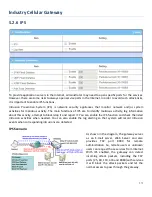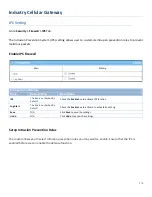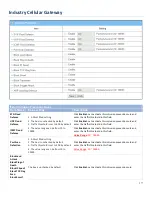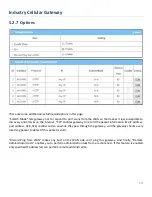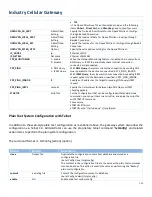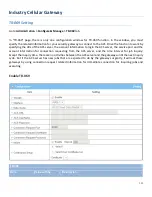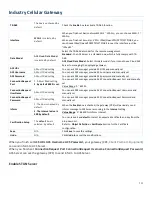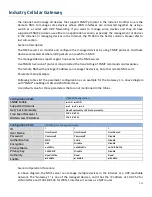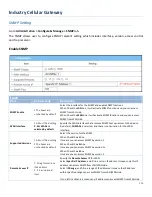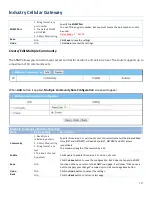
Industry Cellular Gateway
•
TLS
->The OpenVPN will use TLS authorization mode, and the following
items
CA Cert.
,
Client Cert.
and
Client Key
need to specify as well.
OPENVPN_CA_CERT
A Must filled
Setting
Specify the Trusted CA certificate for the OpenVPN client. It will go
through Base64 Conversion.
OPENVPN_LOCAL_CERT
A Must filled
Setting
Specify the local certificate for OpenVPN client. It will go through
Base64 Conversion.
OPENVPN_LOCAL_KEY
A Must filled
Setting
Specify the local key for the OpenVPN client. It will go through Base64
Conversion.
OPENVPN_EXTRA_OPTS
Options
Specify the extra options setting for the OpenVPN client.
IP_ADDR1
Ip
Ethernet LAN IP
IP_NETM1
Net mask
Ethernet LAN MASK
PPP_MONITORING
1 : enable
0 : disable
When the Network Monitoring feature is enabled, the router will use
DNS Query or ICMP to periodically check Internet connection –
connected or disconnected.
PPP_PING
0 : DNS Query
1 : ICMP Query
With
DNS Query,
the system checks the connection by sending DNS
Query packets to the destination specified in PPP_PING_IPADDR.
With
ICMP Query,
the system will check connection by sending ICMP
request packets to the destination specified in PPP_PING_IPADDR.
PPP_PING_IPADDR
IP
Specify an IP address as the target for sending DNS query/ICMP
request.
PPP_PING_INTVL
seconds
Specify the time interval for between two DNS Query or ICMP
checking packets.
STARTUP
Script file
For the configurations that can be configured with standard Linux
commands, you can put them in a script file, and apply the script file
with STARTUP command.
For example,
STARTUP=#!/bin/sh
STARTUP=echo “startup done” > /tmp/demo
Plain Text System Configuration with Telnet
In addition to the web-style plain text configuration as mentioned above, the gateway system also allow the
configuration via Telnet CLI. Administrator can use the proprietary telnet command “
txtConfig
” and related
action items to perform the plain system configuration.
The command format is: txtConfig (action) [option]
Action
Option
Description
clone
Output file
Duplicate the configuration content from database and stored as a
configuration file.
(ex:
txtConfig clone /tmp/config
)
The contents in the configuration file are the same as the plain text commands
mentioned above. This action is exactly the same as performing the “Backup”
plain text configuration.
commit
a existing file
Commit the configuration content to database.
(ex:
txtConfig commit /tmp/config
)
enable
NA
Enable plain text system config.
286




